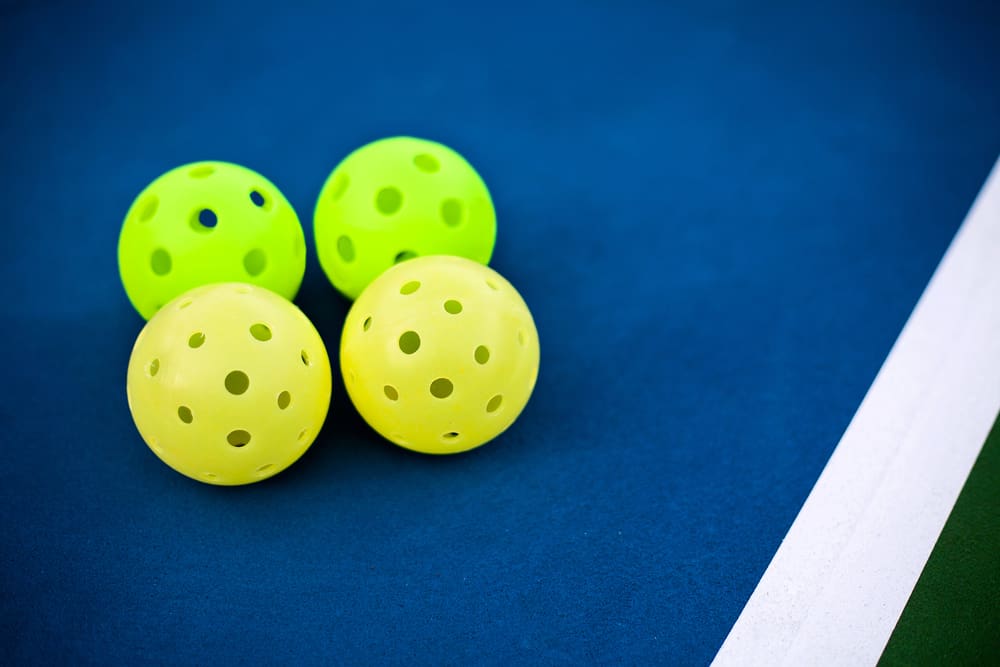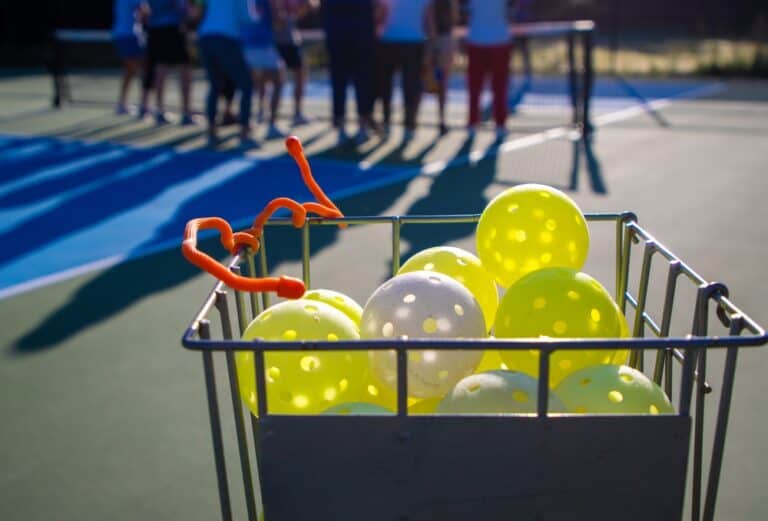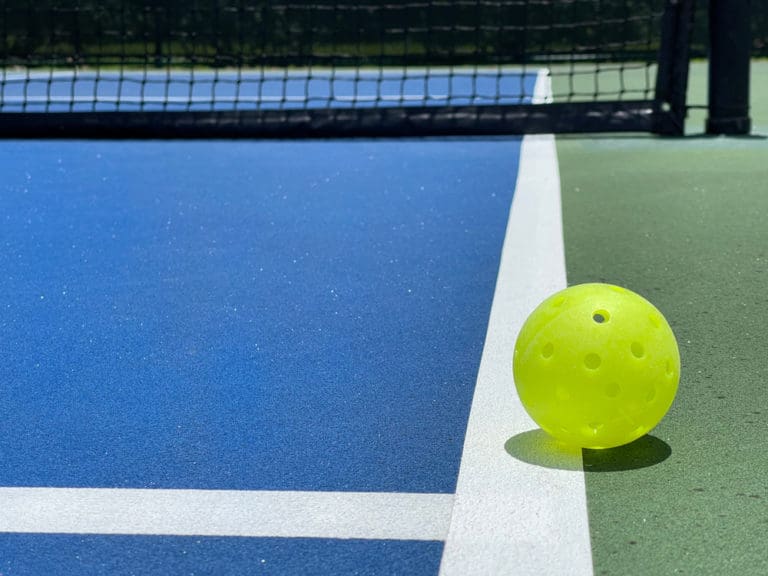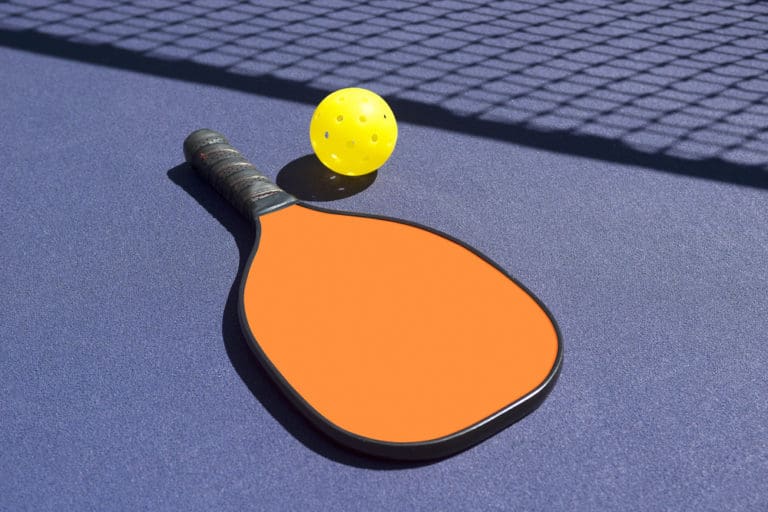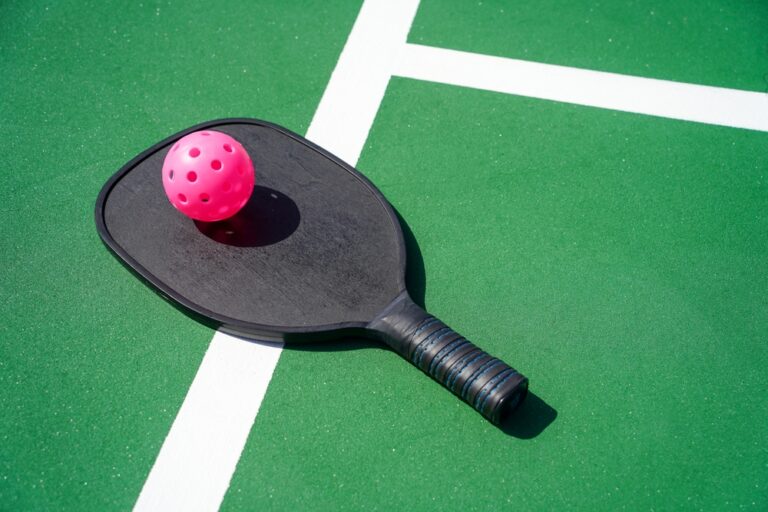What Is A Pickleball Made Of?
Pickleballs are made of hard plastics, resins, or polymers, and there are many different types. Their hardness and construction depend on whether they are intended for outdoor or indoor use, games at tournament level, or just for fun. Playing with the right type of ball makes the game much more enjoyable, while playing with the wrong kind may leave players frustrated and disheartened.
A pickleball is typically made of hard plastic. Depending on the brand, some balls are made of slightly softer plastics than others, and there are variations in characteristics between balls intended for indoor and outdoor use. The latter are harder, larger, and more resistant to wind and impact.
The material from which a pickleball is made results in differences in playability. Balls made of softer materials are easier to control but don’t travel as far or as fast as balls made with harder ones. We explore this in more detail below so that you know how to choose the right pickleball for your game.
Materials Pickleballs Can Be Made Of
Indoor pickleballs may be made of tough, smooth foam, but these are not approved by the USA Pickleball Association. They can only be used for casual play, but because they are less noisy, many people like to use them indoors – at the gym, for instance. Usually, pickleballs are made of plastic.
The USAPA has issued specifications on what pickle balls must be made of in general terms. It says they must be made of a durable material with a smooth surface. This could mean resins, rubber, plastic, or a mixture of various substances. However, the ball has to meet certain specifications according to the rules of pickleball.
For instance, manufacturers are not permitted to give texture to the ball, and there are restrictions on the number and shape of the holes. The International Federation of Pickleball (IFP) and the USAPA have lists of approved balls on their websites accepted for use in their tournaments.
According to the rules, the ball must be made of smooth molded material and a uniform color. It must have between twenty-six and forty circular, evenly spaced holes. When the ball is dropped from a height of seventy-eight inches, it must bounce between thirty and thirty-four inches high.
The hardness of the plastic is a critical factor because a pickleball must maintain its round shape and be able to bounce. If it goes out of round, it is no longer suitable for gameplay and will not fly true. The out of round variance must not exceed around 0.02 inches according to the official rules.
There is no technical specification as to the exact material a pickleball must be made of, but it must meet hardness, weight, and size requirements. The weight must be between 0.78 and 0.935 ounces, and the diameter must be between 2.874 inches and 2.972 inches.
The ball must have a hardness of between forty and fifty on the Durometer Shore D Scale. This Scale indicates the hardness of hard plastics, rubbers, and semi-rigid plastics. Technically a pickleball can even be made of hard rubber if it meets the weight, bounce level, diameter, and other technical specifications.
To make a pickleball, a single heated piece of plastic or a thermoplastic resin is injected into a mold which is then rotated to form the rounded shape. Many outdoor pickleballs don’t have a seam, but a slight seam ridge is permitted, provided it does not affect the ball’s flight characteristics. Indoor pickleballs usually consist of two halves fused together and often have a seam.
Low-Density Polyethylene or LDPE is one of the types of plastic that pickleballs can be made of. It falls into Plastics Category 4 for recycling purposes. Other types of plastics are High-Density Polyethylene, PET, PVC, and Polypropylene.
Not all plastics are suitable for making pickleballs. Manufacturers have their trade secrets regarding the materials they use for the ball.
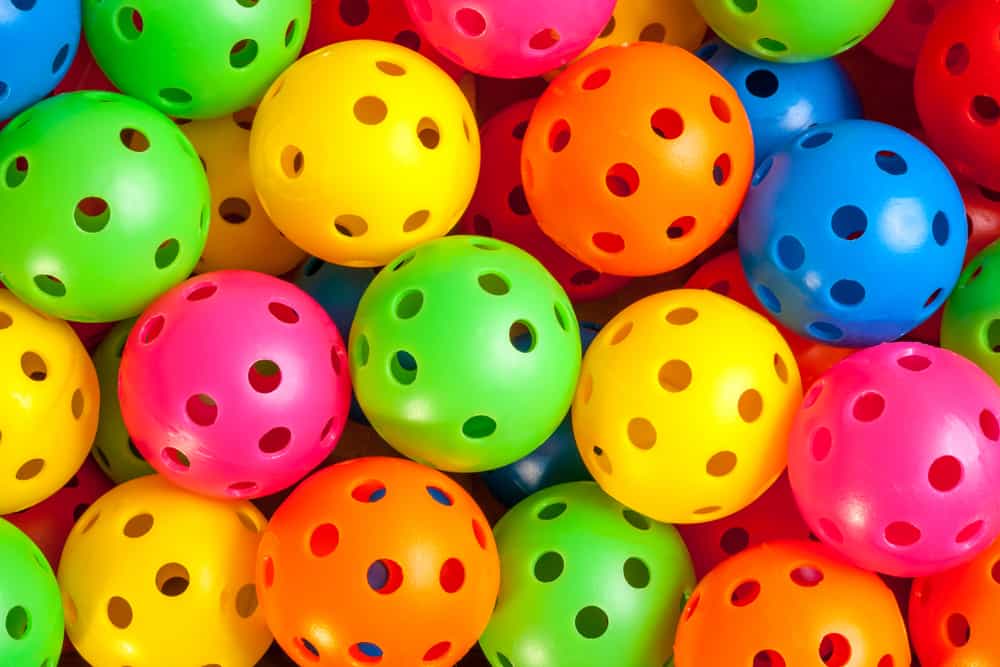
What Are Indoor Pickleballs Made Of?
Indoor pickleballs are made of softer plastic than outdoor ones because the surface of indoor courts usually isn’t as hard and rough on the ball. Indoor court surfaces can be made from wood, tiles, or various synthetic materials, and they differ in how much energy they absorb. This significantly affects how the ball’s material reacts to the court.
Indoor balls are lighter and have bigger holes than outdoor balls. These balls are unlikely to crack and typically last more rounds than an outdoor ball. They are easier to control, but it is difficult to hit them as hard. Rallies tend to go on longer in indoor games.
The material of the ball affects how the court abrades it, how high it bounces, and the rebound angle off the surface. Even the temperature affects the playability of the ball. The softer material of indoor pickleballs compresses more when struck with the paddle.
Indoor balls weigh around 0.8 ounces and are a bit smaller than outdoor balls. They have larger but fewer air holes because the wind is not an issue when playing indoors. The hardness of the plastic can vary between brands, so for instance, the popular Jugs indoor pickleball is a bit softer than the Onix indoor ball.
Outdoor Pickleballs
Outdoor pickleballs are made of heavier, harder plastic and come off the paddle faster and harder. Getting hit by one hurts a person more than an indoor ball. These balls have thicker walls than indoor balls and usually don’t have seams because of the rotational molding process.
Using an outdoor pickleball indoors is not recommended because if the court’s surface is smooth, it will skid, significantly reducing playability. People sometimes use indoor pickleballs for outdoor games because they like the superior control these balls offer. Still, indoor balls aren’t suitable for windy conditions and are not as resistant to impacts on outdoor courts.
Outdoor balls have smaller holes, it is easier to hit them hard, and they are not likely to be affected by the wind. The ball should be appropriately weighted to fly straight and true instead of wobbling unpredictably.
They eventually crack and become unplayable, but their lifespan depends on weather conditions, court surface, and how hard they are played. They are a bit harder in cold weather than in hot weather as temperature affects the plastics they’re made of.
Rick Bell, a pickleball instructor, and tournament winner, said that when he played in Utah, the ball’s playability characteristics changed distinctly between morning and afternoon play. The morning temperatures were around thirty-eight degrees, while they were around eighty-eight in the afternoon. He was using a ball by a reputable manufacturer, so ball quality was not the issue.
Outdoor balls weigh around 0.9 ounces and are slightly larger than indoor balls. TOP, Onix, and Dura are some of the most popular brands of outdoor pickleballs and are very similar in playability. The Franklin X-40 Pickleball is currently the official ball of the outdoor US Open and USA Pickleball Championships.
However, there are over fifty balls listed on the USAPA and IFP websites. There is no restriction on what color the balls must be.
Conclusions
There are no technical specifications on what pickleballs must be made of, but they are usually hard plastic or thermoplastic resin. The technical requirements on how high the ball is allowed to bounce, its diameter, weight, and hardness are likely to restrict the range of materials used to make it. Some indoor balls are made of foam but are only used in casual play and practice.
References
- https://www.coastalpoint.com/sports/pickleball-points-pickles-plastic-and-pickleballs/article_ea42c82a-c86e-59d9-903e-66a0ac7e1881.html
- https://pickleball.land/pickleball-balls-ultimate-guide/
- https://picklrz.com/news/cheetah-pickleballs-can-be-recycled/
- https://www.ifpickleball.org/newpage
- https://equipment.usapickleball.org/ball-list/
- https://www.pickleballrush.com/how-to-play-pickleball/equipment-specifications/ball
- https://www.pickleballmax.com/2019/02/pickleballs-newbie/
- https://www.pickleballcentral.com/Pickleball_Selection_Guide_Balls_s/158.htm

